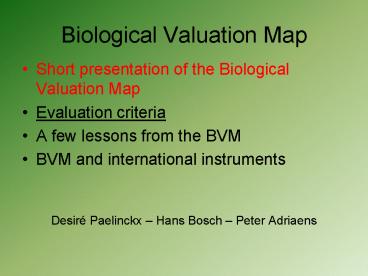Biological Valuation Map - PowerPoint PPT Presentation
1 / 23
Title:
Biological Valuation Map
Description:
A uniform survey of land cover and a biological evaluation of the ... uniform mapping remains a critical issue several joint excursions per year. evaluation ... – PowerPoint PPT presentation
Number of Views:25
Avg rating:3.0/5.0
Title: Biological Valuation Map
1
Biological Valuation Map
- Short presentation of the Biological Valuation
Map - Evaluation criteria
- A few lessons from the BVM
- BVM and international instruments
- Desiré Paelinckx Hans Bosch Peter Adriaens
2
What is the BVM ?
3
What is the BVM ?
- A uniform survey of land cover and a biological
evaluation of the Flemish Region - An ecological description of the Flemish Region
- A fixed set of legend units for
- land cover
- (woods, arable land, pasture, urban areas.)
- vegetation
- (wet grassland, wet heath.)
- landscape elements
- (tree rows, ponds, sunken roads.)
4
field survey
Data from literary study - municipal nature
development schemes - land consolidation
studies - scientific journals - ...
Digital data - topographical map NGI - aerial
photos OC-Gis Vl. - soil map NGI - bvm version
1 - thematic studies - species databases -...
- External data
- nature societies
- - nature reserve managers
- - foresters
- - volunteers
- -...
BVM version 2
5
BVM versions
- 1978 - 1996 BVM, version 1
- Global landscape ecological situation
- 1997 - 2006 BVM, version 2
- More accurate and detailed instrument that can
be used at parcel level
6
Biological Valuation Map
- Short presentation of the Biological Valuation
Map - Evaluation criteria
- A few lessons from the BVM
- BVM and international instruments
7
Evaluation criteria
- best professional judgements, with the following
criteria - Rareness of the habitat
- General biological quality
- flora (and fauna) diversity
- Potential occurrence of rare flora (and fauna)
- Importance of the habitat as a refuge for species
- Global vulnerability to overfertilization,
acidification,.... - Replaceability time required to create the
habitat and to evolve to a certain ecological
balance
8
Evaluationeach habitat has its own fixed
valuation
- Mixed valuations for complexes. E.g. hp (w) kn
(z) becomes (wz) - With well-reasoned arguments it is allowed to
deviate from these fixed valuations
9
Shading because of fauna
10
Fauna
Fauna (red shading), systematic method, good
frame of reference
- Red List species of mammals, breeding birds,
amphibia and reptiles, fishes, dragonflies and
butterflies - Wintering waterfowl 5 standard
Spined loach
gadwalls, wigeons etc
Badger
Water rail
11
Biological Valuation Map
- Short presentation of the Biological Valuation
Map - Evaluation criteria
- A few lessons from the BVM
- BVM and international instruments
12
The purpose requires a very strict method
Outlining the different steps accurately
What is the target exactly?
How to process, interpret, and present data?
What is the best method for gathering information?
What basic information must be gathered?
13
self-criticism
14
Shortcomings of the BVM version 1
they had been warned !!
15
Problems with the BVM originate from
- uncertainties in legend units
- uniform mapping remains a critical issue ?
several joint excursions per year - evaluation
- period of time
16
Shortcomings of the BVM
- lack of description of the horizontal relations
between units and areas
- lack of a clear connection between the abiotic
environment and the mapping units
17
Ecological relations or vulnerabilities cannot be
inferred directly
18
Time frame crucial for grasslands and forests
with springtime flora if the mapping units become
more detailed but the survey cannot be performed
in an optimal fashion (e.g. at the right moment),
the accuracy that seems to be created is
misleading
detail mapping / scale mapping / period and time
available
balance
19
Biological Valuation Map
- Short presentation of the Biological Valuation
Map - Evaluation criteria
- A few lessons from the BVM
- BVM and international instruments
20
BVM Natura2000
- Ideal for defining and making a first assessment
of habitat types - Difficulties
- Restrictions typical of the BVM
- Restrictions typical of the conversion of the BVM
into habitats
21
- Restrictions typical of the conversion of the BVM
into habitats - A number of BVM mapping units are used both for
habitat and non-habitat ? possible habitat - A number of BVM mapping units are used for
different habitats ? habitat 1, habitat 2, - Some habitats cannot be inferred from the BVM
- ? not in the derived database
- Others are difficult to infer as they are only a
minor part of the mapping unit they belong to ?
habitat to be checked
22
Manual checking of the automatic conversion of
existing BVM
23
Habitat key for Flanders
- What further development of habitat sheets for
field surveys, with clearer demarcation of
habitat, less-developed habitat (new in 2004),
and absence of habitat - Target identifying the correct N2000 habitat
type and estimating its percentage in the field
during BVM mapping































